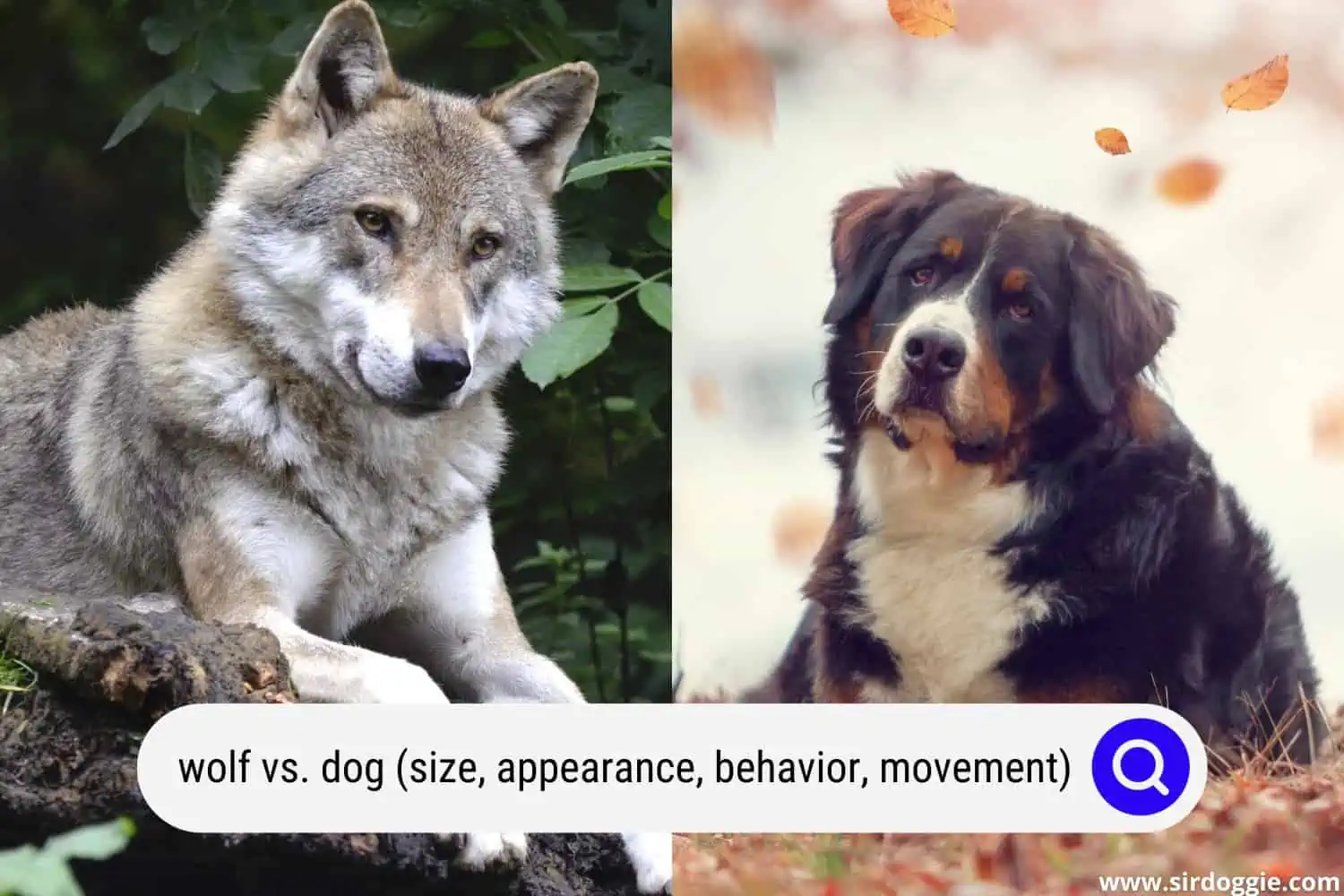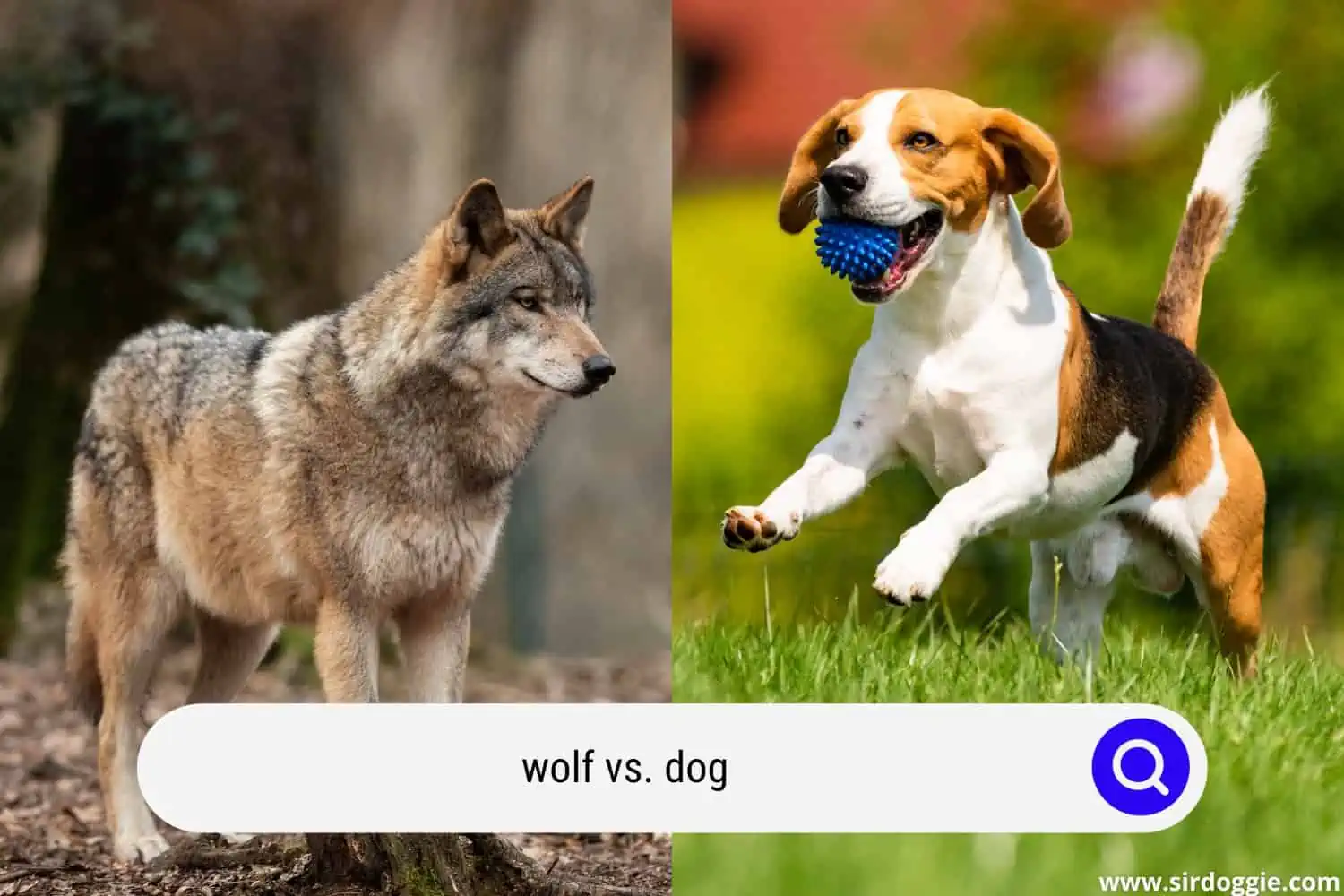Wolf vs. Dog – (Size, Appearance, Behavior, Movement)
Wolves are majestic creatures, yet starkly different from our loveable, domesticated canine pets. Some breeds like the Akita, Alaskan Malamute, Samoyed, and Husky may remind us of wolves, while the Poodle and Pug seem like a far cry from them. Yet, interestingly enough, dogs and wolves share 99 percent of the same DNA. One percent seems insignificant, yet this percentage has a tremendous impact on the differences between the two.

What is the difference between the dog and the wolf? The difference between wolves and dogs lies in their anatomy. Wolves are wild creatures, more enormous than dogs, and they have more prominent jaws and longer legs and tails. Dogs are domesticated creatures that are smaller than wolves and depend on humans for their survival.
| Wolf | Dog | |
| Size | Larger than a dog | Smaller than a wolf |
| Feet | Big paws with two extra-large webbed front toes | Smaller and flatter feet than wolves |
| Tail | Bushy, long, and straight | Range from being similar to a wolf to a tight pig-like curl |
| Eyes | Smaller eyes that range from yellow to amber – but never brown | More enormous eyes that range from blue to brown |
| Ears | Furry ears, triangular-shaped, and set high on the head | Range from triangular to long and floppy |
| Teeth | 42 teeth set in big jaws and has a tremendous biting force | 42 teeth less strong than wolves |
| Coat | White, black, grey, or brown | All kinds of colors |
| Sound | Primarily howls but can growl, whine, yip, or whimper | Primarily barks but can whine, grunt, howl, whimper, and sigh |
| Diet | Carnivores (meat eaters) | Detritivores (scavengers) |
| Running style | Wolves run smoothly and sneakily | Dogs bob around when running |
| Pawprints | Single tracking | Side by side |
| Behavior towards humans | Avoid human interaction | Displays internally coordinated responses based on contact with humans |
| Behavior towards own kind | Wolves are friendly and protective of their pack | Dogs are friendly and willing to get along in groups, but not all dogs are natural communicators |
| Behavior toward other animals | Intolerant of other dog-like carnivorans | Much more accepting of other animals |
Wolves couldn’t be more different from dogs. Although some dogs share similar appearances to wolves, distinct features set them apart, not to mention the radical differences in their behavior. So let’s delve into the details.
Wolf vs. dog size
Wolves are generally more giant in height and length than dogs, though there are exceptions. For example, wolves have more oversized heads than their body compared to dogs. In addition, they have narrow hips and chests and long legs, whereas dogs have smaller heads than bodies compared to wolves, wider hips, and chests with shorter legs.
The wolf has two extensive front toes that are webbed. Their webbed toes make it easier for them to swim and track through the snow. In addition, their long legs and big paws help them run at high speeds over long distances.
Wolves weigh 40 to 175 pounds. On the other hand, dogs weigh from 3 to 175 pounds. In terms of wolf vs. dog weight, wolves are heavier. The smaller wolves can weigh up to 75 pounds, whereas dogs are lighter – the average dog weighs about 50 pounds.
Wolf vs. dog appearance
In terms of appearance, some dogs may seem a lot like wolves. So, let’s look at what sets wolves and dogs apart and makes them easily identifiable.
Wolves’ eyes are almond-shaped and close-set on their face. Their eyes range from amber to pale yellow and even green. Blue and dark brown/black eyes are characteristics of a dog. Dogs’ eyes are rounder than wolves’ and set wider on their faces, giving them a softer look.
Wolves have big strong jaws, enabling them to crush bones easily, while dogs need to chew on kibble and other food their owners feed them. Both species have 42 teeth, although wolves have longer and thicker canines and prominent molars.
Tails among dog breeds vary – some dogs can have a similar bushy tail to the wolf, but there is a difference in movement. A wolf’s tail remains straight, whether they are still or in motion. An interesting fact to note is that some black and grey wolves’ tails will turn white or grey as they age.
Wolves’ coats are black, white, grey, or brown. They rely on camouflage for survival. Dogs’ coats are mainly black, brown, white, and red. There are many shades of these four colors, such as gold, yellow, cream, and blue, and a dog’s coat may be several of these colors.
Wolf vs. dog behavior
Wolves are territorial creatures that live in packs and are protective of their species. They engage in group behavior such as howling together (this makes it seem like there’s a lot more in the pack). They also nurture injured or sick among their kind.
Dog breeds exhibit different behaviors based on how humans have raised them. They internally coordinate their response based on internal and external stimuli. Some dogs can be aggressive and dominating, but the majority of dogs are generally social.
Wolves steer clear of humans. They rarely attack humans and would rather avoid human contact. However, instances have occurred where wolves attacked humans, but only after being fed by humans, and as a result, they viewed the humans as less threatening.
Wolves are independent. They don’t depend on humans for support and can therefore never be domesticated. On the other hand, dogs are dependent on humans and look for affection.
Dogs are friendly and view us as family. They may or may not accept strangers depending on their breed and how their humans have raised them. Humans have raised some as guard dogs, and some as hunters, but we usually raise them as companions.
Wolves tend to howl, although they can bark, and they have a range of other sounds as well. Dogs primarily bark, although some do howl, and they too have an array of different sounds they make, such as whimpering, grunting, whining, and sighing.
Wolf vs. dog movement
When a wolf walks, its hind legs swing directly behind its front legs, thus leaving a trail in sand, mud, or snow that looks like a single line. We refer to their movement as single tracking. When dogs walk, they leave a zig-zag pattern. Their paw prints tend to appear more side by side.
A wolf’s movement is also very steady. Their gait seems effortless and flowing. On the other hand, we observe dogs’ movements as bouncier, and their walk seems like a trot.
Wolf vs. dog survival instincts
Wolves are carnivores. They’ll prey on elk, deer, and moose much more extensively than themselves or more minor mammals such as beavers, rabbits, and livestock. To prevent starvation, wolves will eat vegetation.
A wolf can kill its prey with one bite – it has a powerful killer bite, whereas dogs have no killer bite. Dogs have no killer bite because hunters have trained them to fetch or prevent their game from escaping but never kill them.
Wolves are also problem solvers. They develop their abilities as cubs because they rely on their instincts to survive, so even cubs can solve complex tasks. Dogs’ problem-solving skills are not as skilled because they know they can depend on their human companion and entice them to help.
Dogs cannot survive without human intervention. They are detritivores meaning they are scavengers and will eat what their human companions give them, ranging from dog kibble to meat, and bones and they’re open to a wide variety of foods we offer them.
Playtime is vital for dogs and wolves. For dogs, playtime is fun and a way to get exercise, but for wolves, it’s a time to learn necessary survival skills such as swimming and hunting.
Because dogs generally lead an easier life, they are not concerned with food or the weather as they depend on us to care for them. They can therefore breed multiple times a year.
Wolves only breed at a specific time of the year. Wolf cubs are usually born in the spring, giving them enough time to learn survival skills and prepare themselves for winter.

Related questions
Can wolves become pets?
No, wolves are not domesticated and will not respond in the manner of dogs. If you’d like to keep a wolflike pet, get a dog breed that looks like a wolf. Popular choices are the Akita, Alaskan Malamute, Samoyed, Husky, and German Shepherd.
Do wolves attack dogs?
Yes. Wolves view dogs as territorial intruders, and for this reason, they will attack and kill dogs. Keep your dogs locked up safe when visiting a wolf territory, and if hiking, leave your dogs behind. Wolves will approach you if your dog is with you.
What dog is most similar to the wolf?
The Siberian Husky. They are one of the most recognizable canines that resemble wolves. They have compact, upright bodies, along with similar eyes as well as erect ears.
What should I do if I encounter an aggressive wolf?
Don’t turn your back to the wolf or run. Instead, make yourself appear scary by shouting, waving your hands over your head, and throwing stones.
Related Reading: Kangal vs. Pitbull: Who Would Win in a Fight?

Family Dog Expert Author
Hi there! I’m Stuart, a devoted dog lover and family dog expert with over a decade of experience working with our furry companions. My passion for dogs drives me to share my knowledge and expertise, helping families build strong, loving bonds with their four-legged friends. When I’m not writing for SirDoggie, you’ll find me hiking, playing with my beautiful dog, or studying music.